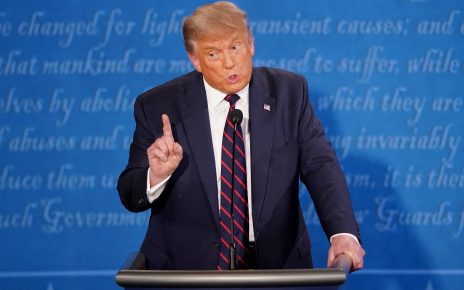Whatever else one might say about the Trump era in American politics, it’s provided a wealth of data for scientists studying public opinion. For those of us interested in “metanarratives”—the stories that groups tell themselves about who they are and where they’re headed—the 2016 and 2020 campaigns have been a gold mine.
Every vision of America has a metanarrative at its core. Are we a land of endless opportunity, a beacon for the world’s huddled masses? Are we the world’s lone superpower, throwing its weight around? Every institution, every social movement and every political campaign offers its own answers to questions like these, and for the people who believe these answers, these stories can be vital to their identity.
The science of metanarratives and how we respond to them is still in its infancy. Our research team, headed by psychologist Gerard Saucier, has uncovered the metanarratives typical of terrorists and genocidal leaders worldwide. More broadly, my own work seeks to understand how the structure and features of metanarratives can elicit emotional responses, and how social factors influence public reactions.
Emotions arise when we make comparisons relevant to our own needs and desires. We contrast our present circumstances with the future, the past and alternative versions of today. Improvements make us happy and inspire us; losses sadden or frustrate us. If we can blame someone else for our loss, we may become angry with them. And if we’re faced with threats, our fear can motivate action. As with fiction, we can categorize metanarratives by their emotional “genres,” such as progress (pride, optimism) or looming catastrophe (fear).
The metanarratives in U.S. presidential elections are usually predictable. Each party wants progress, although the Democratic and Republican “flavors” of progress tend to differ. Each party also wants the stability needed for progress to work, so that policies can have predictable outcomes. The party in office typically offers more progress, or preserving a Triumph its administration achieved; the other promises a course correction back toward its own goals.
Compared with the usual metanarratives, Donald Trump’s 2016 campaign was much more dynamic. First, he introduced a restoration story line, a promise to “Make America Great Again.” This story line contrasts an idealized past and potential future with a fallen present, creating more dramatic emotional contrasts than a course correction. But Trump didn’t stop there. “Drain the Swamp” and even “Lock Her Up!” were examples of transformation—an abrupt end to “business as usual.” His infrastructure expansion plans were classic Progress, and his nomination by the conservative GOP promised the stability valued by party faithful. Voters could latch onto whichever vision most resonated with them, ignoring the others. The drama in Trump’s metanarratives excited new segments of the public and helps explain his appeal, both to Republicans and others (like 12 percent of previous Bernie Sanders voters). As cognitive scientists George Lakoff and Drew Westen remind us, it’s emotion that wins elections.
If we like, we can picture Trump as an amateur scientist, conducting a rudimentary experiment to see if new metanarratives would inspire the public. Meanwhile, the Democrats tried an informal experiment of their own, weighing the motivational power of the usual progress/stability versus a Sanders “revolution” to sharply reorient government priorities. They concluded the temporary loss of stability from a transformation would cause too much collective anxiety, and went with Hillary Clinton, then Joe Biden.
Biden’s early metanarrative choices had been vaguely along the expected course correction line, but by the Democratic National Convention he’d settled on a much stronger genre, the crossroads. Both his slogan, “Battle for the Soul of the Nation” and his references to “inflection points” portray America as at a critical juncture. In narrative terms, this story line sets up suspense between two possible outcomes—as Biden put it, “shadow and suspicion” versus “hope and light”—a suspense that makes our votes meaningful, as we each participate in its resolution.
Trump’s reelection slogan, “Keep America Great,” is a triumph story line that logically follows a restoration, yielding pride and self-satisfaction, but anxiety if the achievement is vulnerable. His RNC speech also featured progress (such as “new frontiers of ambition and discovery”), a course correction (including “returning to full employment” and “rekindle new faith in our values”), and his own version of a crossroads: either “save the American Dream” or “allow a socialist agenda to demolish our cherished destiny.”
Trump’s kitchen-sink approach to conveying a vision for the country means we can’t compare the effectiveness of one metanarrative against another. Such real-world experiments are impractical. However, we can still explore the factors influencing our reactions to different story lines.
The public doesn’t accept every metanarrative it’s offered. We tend to be loyal to the cultural beliefs favored by our social circles and encouraged by our leaders. Even then, some voters stay open to alternatives, if there’s enough dissonance between the party line and their own experiences.
A useful analogy again comes from narrative science. Psychologist Keith Oatley has described three ways to read a book: deeply immersed, such that its emotional world becomes our own; reflectively exploring its ideas by making our own connections and thinking critically; or staying emotionally detached. Similarly, we can treat the metanarratives in our lives as truths we shouldn’t question, potentially valid perspectives we can weigh and choose among, or just plain wrong. Trump favors a “full immersion” approach, with his affinity for sensory-rich rallies and his insistence on personal loyalty. Biden’s give-and-take style aligns more with critical thinking. Which is not to say that there aren’t reflective Republicans or unquestioning Democrats; of course there are.
My personal, untestable hypothesis is that the election’s bottom line will be emotional. As they weigh the personalities, policies, and metanarrative visions offered by the candidates, voters may choose the one who best offers an end to 2020’s turmoil. The newfound appeal of stability could be the deciding factor. And as formal science works to catch up with the intuitive “science” practiced by politicians, we may learn to better understand the functioning of metanarratives in action.



-464x290.png)
